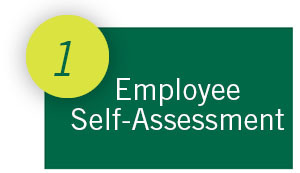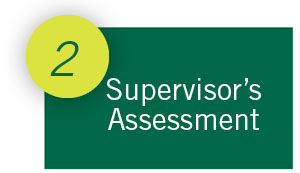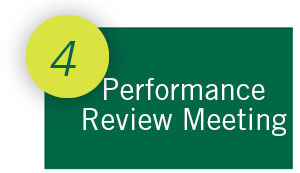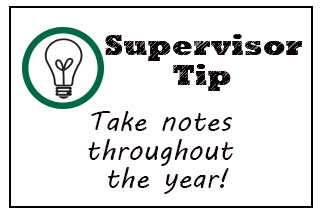At USF, the practice of retaining high performing employees includes building strong working relationships between supervisors and employees. One of the aspects of creating these professional working relationships includes the performance management process. When performance management is completed as an ongoing dialogue between the supervisor and the employee, the results can be engaged, focused and productive employees and a thriving university.
For questions regarding the Performance Management process, training, and key dates, please email training@usf.edu or navigate to the HR Help Center to submit a HR Help Desk ticket.
Performance Management Introduction
(Video Runtime: 5 minutes) This brief video provides an introduction to performance management, including how it can impact employee engagement.
performance management training
Select the drop-down to review the Live Trainings available for Performance Management.
Live & Recorded Trainings
| Date/Time | Audience | Topic | Registration Link |
|---|---|---|---|
| November 03, 2025 | Leaders | Performance Managment for Supervisors | See Program Page for in-person and virtual enrollment options |
| September 15, 2025 | Leaders | Performance Managment for Supervisors | See Program Page for in-person and virtual enrollment options |
| May 27, 2025 | HR Business Partners | Supporting the Annual Evaluation Process | Recording available: Supporting the Annual Evaluation Process (57:20) |
| June 10, 2025 | HR Business Partners | Understanding Performance Calibration | |
| June 2 & 4 , 2025 |
Employees | Completing the Annual Evaluation in Oracle HR | Employee Self-Assessment | Recording available: Completing the Annual Evaluation in Oracle HR (01:04:58) |
| June 2 & 18 , 2025 | Leaders | Enhancing Team Performance: Effective Feedback and New OracleHR Tools | Recording available: Effective Feedback and New Oracle HR Tool (01:04:38) |
| Task | Due Date | Resources |
|---|---|---|
| Worker Self-Evaluation | June 30, 2025 | Completing the Worker Self-Evaluation |
| Manager Evaluation of Workers | July 31, 2025 | Evaluating Employee Performance |
| Current: Calibration | August 15, 2025 | Three Step Calibration Infosheet |
| Next: Performance Review Meeting | September 5, 2025 |
ANNUAL REVIEW TIMELINE
Here, you will find key dates and milestones for the 2024–2025 staff & administrative employee evaluation cycle.
Each date is clickable, allowing you to access detailed information and helpful resources for each step of the process. This timeline is designed to guide you through the performance review process, ensuring you stay on track and have all the necessary tools and information at your fingertips. Explore the timelines below to get started!

May 13 - June 30, 2025
As part of the 2024–2025 staff & administrative employee evaluation cycle, Oracle HR will be utilized to manage performance evaluations across the university. Employees should first enter the performance goals identified in last year’s evaluation into the Oracle HR, Goals Center. These goals will carry over into the FY25 Annual Review. Following this, employees are required to complete their self-assessment by June 30, 2025.
Step 1: Add your goals to Oracle HR
How to Submit Goals in Oracle HR
- Navigate to Oracle HR and sign in.
- From the Me tab, select the Career and Performance tile.
- Select Goals Center.
- Add your goals under the Performance tab.
- Once all goals are added and weights are chosen, click Submit.
Understanding Goal Weights
Goal weights prioritize goals and assign relative importance to each one. A goal’s weight, represented as a numerical value, indicates its importance compared to other goals.
Assigning Goal Weights
- Consultation: Employees and Line Managers should discuss and agree on the weights for each goal.
- Percentage Allocation: Each goal is assigned a percentage weight, ensuring the total adds up to 100%.
- Reflecting Importance: The weight of each goal should reflect its significance to the employee’s role, organizational goals, and personal development.
Example: If an employee has three goals—improving student satisfaction, increasing university revenue, and completing a certification program—the manager and employee agree to assign weights of 40%, 40%, and 20%, respectively. This indicates that improving student satisfaction and increasing university revenue are the most critical goals, followed by completing the certification program.
By following these guidelines, employees and managers can effectively prioritize and manage performance goals, ensuring alignment with organizational objectives and personal development needs.
Need help?
A step-by-step course and PDF are available within Oracle HR.
- Navigate to Oracle HR and sign in.
- From the Me tab, select the Learning tile.
- Choose Learning Catalog in the bottom left-hand corner.
- Search for “Oracle HR | Performance Management | How to Add a Performance Goal.”
- Take the self-paced course and review the PDF guide, if necessary.
Step 2: Prepare for Your Evaluation
When completing the FY25 USF Annual Review, you’ll be asked to:
- Document your accomplishments
- Reflect on key projects or events that may have influenced your performance
- Identify areas for growth and professional development
- Instructions for completing the full evaluation will be available starting June 1, 2025.
Reminder Communication Sent: May Deadline for the Annual Review Process

July 2 - July 31, 2025
- Supervisors take employees' self-assessments into consideration when completing reviews.
- For the 2024–2025 evaluation cycle, you will use Oracle HR to manage your employees’ evaluations.
- Supervisors should review their employees' self-evaluations in preparation for calibration meetings.
- Supervisors should refrain from returning performance reviews to employees until after the calibration meetings.

August 1 - August 15, 2025
- Performance management calibration sessions help leaders apply consistent standards across their teams, ensuring all employees are evaluated using the same scale.
- Calibrations may be conducted by department, employee level, or job function.
- Supervisors should hold calibration meetings with other leaders within their unit and their HR Business Partner (HRBP).
Performance Calibration Sessions
Resource: Three Step Calibration Infosheet
After employee performance appraisals are completed, a performance review calibration meeting is organized with managers, senior leadership, and an HR representative acting as the facilitator. This meeting ensures that all employees are evaluated using consistent standards.
The calibration meeting aims to review employee appraisals and performance ratings to ensure uniformity. It helps identify discrepancies where some managers may rate employees as high performers while others rate employees with similar performance as average. Through discussions, participants adjust individual ratings to align with standards, ensuring accurate and consistent evaluations.
Additional Tips
- Completion: Managers should complete appraisals and assign ratings before the calibration meeting.
- Efficiency: Limit the number of participants to facilitate quicker consensus and avoid lengthy meetings.
- Representation: Include leadership from each department to accurately represent the expected work and metrics for roles within their department. For example, a VP of Engineering may not have the necessary background to appraise the work of a sales team.
- Segmentation: Break up departments into smaller groups if needed to ensure focused discussions.

August 18 - September 5, 2025
- Supervisors may begin annual performance review meetings once unit calibration sessions are complete.
- The final performance review meeting between the employee and supervisor must be conducted, and the evaluation submitted in Oracle, by September 5, 2025.
Merit Award / Bonus Pay (Sept. 20, 2025)
If applicable, spreadsheets for merit award/bonus pay for out-of-unit employees must be submitted by September 20, 2025.
Guidelines for Compensation Planning
See the Guidelines for Compensation Planning here (employee login required to view in HR Hub). Please note that in-unit employees will be compensated in a manner consistent with their respective Collective Bargaining Agreement (CBA).

Why is it important to take notes throughout the year?
- Identifying Trends: Regular note-taking helps supervisors identify performance trends over time, providing a comprehensive view of an employee's progress and areas for improvement.
- Avoiding Common Evaluation Traps:
- Affinity Bias: Helps prevent favoritism based on personal affinity, ensuring evaluations are based on actual performance.
- Excessive Leniency: Ensures that evaluations are fair and balanced, avoiding overly lenient assessments that may not reflect true performance.
- Job Importance vs. Goal Attainment: Keeps the focus on achieving specific goals rather than just the perceived importance of the job role.
- Providing Backup: Detailed notes serve as evidence if any action is needed, supporting decisions with documented observations.
- Reference for Annual Review: Notes provide a valuable reference during the annual review meeting, helping supervisors recall specific instances and examples to support their evaluations.
STAGES OF THE PERFORMANCE MANAGEMENT CYCLE
1. Performance Planning for the Year Ahead
- Clarify the expectations and standards for the job.
- What's expected of someone in this role? What standards must be maintained?
- Set performance goals: What will the employee strive to achieve in the coming year?
- Set development goals: What knowledge/skills will the employee work to develop or enhance in the coming year?
Tips for Performance Planning for the Year Ahead & Clarifying Expectations
ASSIGNMENTS AND POSITION DESCRIPTIONS
The employee and supervisor need to have a shared understanding of how well the employee is doing. For this, duties and responsibilities must be clarified to provide a framework. The first step in clarifying understanding of the job is to make sure the position description is accurate and up to date. The employee should see a copy of the position description and have an opportunity to ask any questions. Keep in mind that the same job title will likely have different duties from one department to another.
FOR SUPERVISORS: USE SMART GOALS
How do you know if goals are being met? Set specific achievement markers by using SMART goals. Utilize the SMART goals worksheet (employee access required to view in HR Hub), and view the online LinkedIn Learning video, Setting Team and Employee Goals using SMART Methodology (Total run time: 55 minutes).
Need help accessing LinkedIn Learning videos? Learn about free USF employee access here.
2. Daily Coaching & Feedback
Discuss performance often. Effective coaching occurs through conversations. These conversations occur regularly, rather than being reserved for formal reviews. Share feedback about the employee's successes and areas needing improvement. Discuss training needs as they arise. The conversation should be back and forth; seek employee input about the work process and results.
Tips for Daily Coaching & Feedback
Keep conversations balanced to address strengths as well as concerns. For example:
- How is the employee doing handling their workload?
- Does the employee need help or motivation?
- Is there something done well that can be recognized?
Provide appreciative feedback and recognize successes. Pay attention between conversations to catch people in the act of doing great work. Thank people in person and attach praise to meaningful results. Instead of just good job, try, the solution you offered helped us to avoid a potential problem and exceeded the client’s expectation.
Address concerns and solve problems. Be timely and address concerns as the needs arise, but only address a manageable number of concerns at one time. When addressing problems with the employee’s performance:
- Be specific and give examples
- Focus on observable actions and their impact
- Focus on problem resolution rather than blame
- Collaborate to accurately define the problem and brainstorm solutions
- Present your view of the problem. If the problem is a concern you have about the employee’s actions, consider the Action- Impact format to present your concern.
Action-Impact Format
Conversation steps when addressing performance concerns or problems:
- State the action (behavior) you observed.
- Describe the impact the action had on results.
- Invite and hear the other’s view of the problem.
- Listen non-defensively and seek to understand the other’s perspective.
- Identify a definition of the problem that is agreeable to both of you.
- Brainstorm possible solutions.
- Agree on a strategy to implement.
- Schedule a follow-up meeting to check the success of the strategy.
3. Quarterly Performance Check-In
- Are short term objectives being met to indicate that goals will be achieved?
- Are expectations still clear? Review or clarify any standards not being met.
Tips for the Quarterly Performance Review
The quarterly check-in is a “progress check” conversation at least once per quarter to review goals, progress and results. It is time to acknowledge successes and identify improvement opportunities. The following should be considered in the quarterly check-in:
- Is the employee meeting expectations and standards?
- Is the employee achieving performance goals?
- Is the employee achieving developmental goals?
If any areas cause concern, make mid-course adjustments where needed and review or clarify any standards not being met.
- What changes would enhance performance or progress toward the goal?
- Are expectations still clear?
The quarterly check-in should be scheduled ahead of time, allowing both the employee and supervisor time to gather all necessary information. It may be helpful to have the employee complete a self-report before the meeting.
4. Formal Performance Review
- Meet annually to review and document feedback from the previous year.
- Were performance goals achieved?
- Were professional development goals achieved?
- This segues into performance planning for the next year.
Tips for the Formal Performance Review
During annual performance reviews, supervisors and employees work together to:
- Review the employee’s work achievements and challenges over the past year.
- Establish work expectations and performance goals for the coming year.
- Define the employee’s professional development goals and learning plan for the coming year.
The forms utilized in this process will assist supervisors and employees in preparing for performance review discussions. Although these forms are helpful and necessary tools, the filling out of forms is not the primary goal of a review. Reviews are most effective when forms are used to help prepare for a conversation and document the outcomes, rather than as a substitute for the conversation.
Preparing for the Formal Review
Review the following:
- The employee’s position description (PD)
- Standards and expectations
- Past year’s goals and objectives
- Other documentation gathered during the review period
Ask the employee to prepare by reflecting on the following:
- Successes and challenges over the past year
- Additional support he or she would like from you
- Additional skills/knowledge he or she would like to develop or enhance
Complete an Evaluation Form. Be prepared to share your perceptions and feedback about the employee’s performance over the past year, including:
- Key achievements and successes
- Performance concerns and/or challenges
- Changes and enhancements that you recommend (or require)
- Learning opportunities relevant to the employee’s job function that would help enhance current skills or develop new ones
- Key employee strengths and contributions over the past review period
Conducting the Review
- Share your feedback about the employee’s performance, including information about strengths and successes as well as areas needing improvement.
- If assigning ratings, communicate the rating you’ve assigned for each of the performance indicators. Provide rationale for each rating - include behavioral examples whenever a rating is above or below “achieves.”
- Invite and listen to the employee’s assessment of his/her performance. Ask the employee to share his/her feedback for you, including ideas for improvement.
- Re-enter the performance planning phase for the following year.
UNIVERSITY SPECIFIC CONSIDERATIONS
Types of Performance Reviews
USF has three types of performance reviews:
-
Annual Performance Review: This is a comprehensive evaluation conducted once a year for all employees. It assesses overall performance, goal attainment, and development needs over the past year. The annual review is crucial for setting new goals and identifying areas for professional growth.
-
Probationary Performance Review: This review is conducted for new employees or those in a probationary period. It typically occurs at the end of the probationary period to evaluate the employee's performance, fit within the organization, and readiness for continued employment. The probationary review helps ensure that new hires meet the expectations and standards of their role.
-
Special Performance Review: A special review is conducted outside the regular review cycle, often triggered by specific circumstances such as performance issues, significant changes in job responsibilities, or after completing a major project. This review provides an opportunity to address and document performance concerns or achievements promptly.
Evaluation Dates
Annual performance reviews for most employees will be conducted using the fiscal year (July 1 – June 30).
Probationary Employees
View the Probationary Employees Procedure here. Additional information and procedures can be found in the Staff Performance Management Procedure and in the Staff Progressive Discipline Procedure. (Employee access is required to view documents in the HR Hub)
Performance Improvement Plan (PIP) Process
For Staff Employees
Employees with a substandard evaluation will be placed on a Performance Improvement Plan (PIP).
For Administration Employees
Administration employees receive an action plan for improving performance and one performance evaluation either at the start or end of the improvement period.
Performance Improvement Plan (PIP)
- The PIP outlines the standards and expectations based on the duties, responsibilities, and requirements of the position that must be met to achieve an overall "Achieves" rating.
- See the Performance Improvement Plan format here. (Employee login required to view document in HR Hub)
UNDERSTANDING THE PROCESS
Implementation
- Supervisors should collaborate with their Service Center HR Manager, who will send a letter outlining the PIP process.
- Supervisors need to send weekly or biweekly updates to their Service Center HR Manager.
Improvement Period
- The improvement period must be at least 60 calendar days from the date the employee received the PIP.
- Additional time can be requested, up to a total of six months from the date of the PIP.
Follow-Up Evaluation
- At the end of the improvement period, a follow-up Special Evaluation is conducted.
- Possible outcomes:Rating revised upwards
- Extension of the improvement period requested
- If no improvement, employee's dismissal proposed
- Alternatively, the employee may be demoted to another job instead of terminated
Collective Bargaining Agreements (CBAs)
Collective Bargaining Agreements (CBAs) should be thoroughly considered during the performance management process.
For example, a CBA may make provisions for an employee who does not meet performance standards. Each union has their own agreement; review the most up-to-date agreements online via the Central Human Resources - Collective Bargaining and Labor Relations site.
Employee Relations (ER)
Employee Relations (ER) provides education, training, mentoring and guidance to individual employees, supervisors, managers and administrators to address questions and workplace issues for non-Faculty employees.
HR Managers work with department administrators and individual employees on effective employee-manager communications and provide individual coaching to improve employee performance and resolve conflicts and problems before the point of formal corrective action and grievance.
HR Managers advise on and interpret University policies, procedures, regulations, labor contracts, key state statutes and federal laws, and oversee the University layoff, progressive discipline, performance improvement plan, and non-reappointment processes.
ER SERVICES
- Performance management
- Complaint resolution and conflict mediation
- Counseling and formal discipline
- Collective bargaining agreement compliance
- Grievance procedures
- Applicable alcohol/drug testing (pre-employment and regulatory)
Forms & Procedures
FORMS
USF Graduate Assistant Performance Evaluation
Performance Improvement Plan Format (Employee access required to view in the HR Hub)
SMART Goals Worksheet (Employee access required to view in the HR Hub)
Looking for the annual evaluation form? This year, we are using Oracle HR to manage performance evaluations across the
university. As an alternative, a paper form is provided here:
Employee Performance Review 2025
PROCEDURES (Employee access required to view these forms in the HR Hub)
Staff Performance Management Procedure
Frequently Asked Questions
Who can I contact for more information?
If you have any questions, please utilize these options:
- Reach out to us at: training@usf.edu
- Submit an HR Help Center > HR Help Desk: General Questions ticket.
Is the expectation that employees set their own goals, or do managers set goals for employees?
Leaders are strongly encouraged to collaborate with their teams to develop individual employee goals that support both departmental priorities and overall organizational success. This collaborative approach ensures alignment with the department’s strategic objectives and promotes shared ownership of outcomes. Alternatively, leaders may choose to establish and cascade goals to their direct reports based on broader unit or divisional priorities.
All goals must be SMART (Specific, Measurable, Achievable, Relevant, and Time-bound) and clearly aligned with the department’s goals and the University of South Florida’s mission, vision, and strategic initiatives. This alignment helps ensure every employee understands how their contributions support the university’s commitment to excellence, innovation, and student success.
Do employees who started after last year's evaluation period and are not on a probationary period need to submit goals by the set date?
Yes, employees who started after the last evaluation period should have had expectations set by their managers. These expectations can serve as their goals for this year to assess their performance. When the window opens to insert next year's FY goals, the manager and employee should utilize SMART Goals Worksheet to build performance goals.
How do I align weights to goals in Oracle HR?
Goal weights prioritize goals and assign relative importance to each one. A goal’s weight, represented as a numerical value, indicates its importance compared to other goals.
Assigning Goal Weights
- Consultation: Employees and Line Managers should discuss and agree on the weights for each goal.
- Percentage Allocation: Each goal is assigned a percentage weight, ensuring the total adds up to 100%.
- Reflecting Importance: The weight of each goal should reflect its significance to the employee’s role, organizational goals, and personal development.
Example: If an employee has three goals—improving student satisfaction, increasing university revenue, and completing a certification program—the manager and employee agree to assign weights of 40%, 40%, and 20%, respectively. This indicates that improving student satisfaction and increasing university revenue are the most critical goals, followed by completing the certification program.
By following these guidelines, employees and managers can effectively prioritize and manage performance goals, ensuring alignment with organizational objectives and personal development needs.
Will we use the same form as 2024? Will older forms be accepted for this performance review cycle?
No, we will not use paper forms this year. As part of the 2024–2025 evaluation cycle, Oracle HR will be utilized to manage performance evaluations across the university. All evaluations will be conducted electronically through Oracle HR, ensuring a streamlined and efficient process. Older paper forms will not be accepted for this cycle.
How will we get all the updated and needed information about the Performance Management Processes?
Visit the Live Webinars page, Project Drive Training & Resources page, or find Oracle Guided Learning (OGL) guided learning resources within Oracle HR.
Are goals and values both part of the Employee's Self-Assessment and the Manager’s assessment?
Yes, both the employee and their supervisor are asked to incorporate the values while assessing their goals in their performance evaluations.
Is there still a probationary evaluation?
Yes, the University of South Florida (USF) continues to conduct probationary evaluations for new staff employees. These evaluations are managed within the Oracle HR system. If you require assistance with probationary evaluations or have questions about the process, please contact USF Employee Relations. They offer guidance on evaluation procedures, performance improvement plans, and related policies. You can reach them through the Employee & Labor Relations page by clicking here.